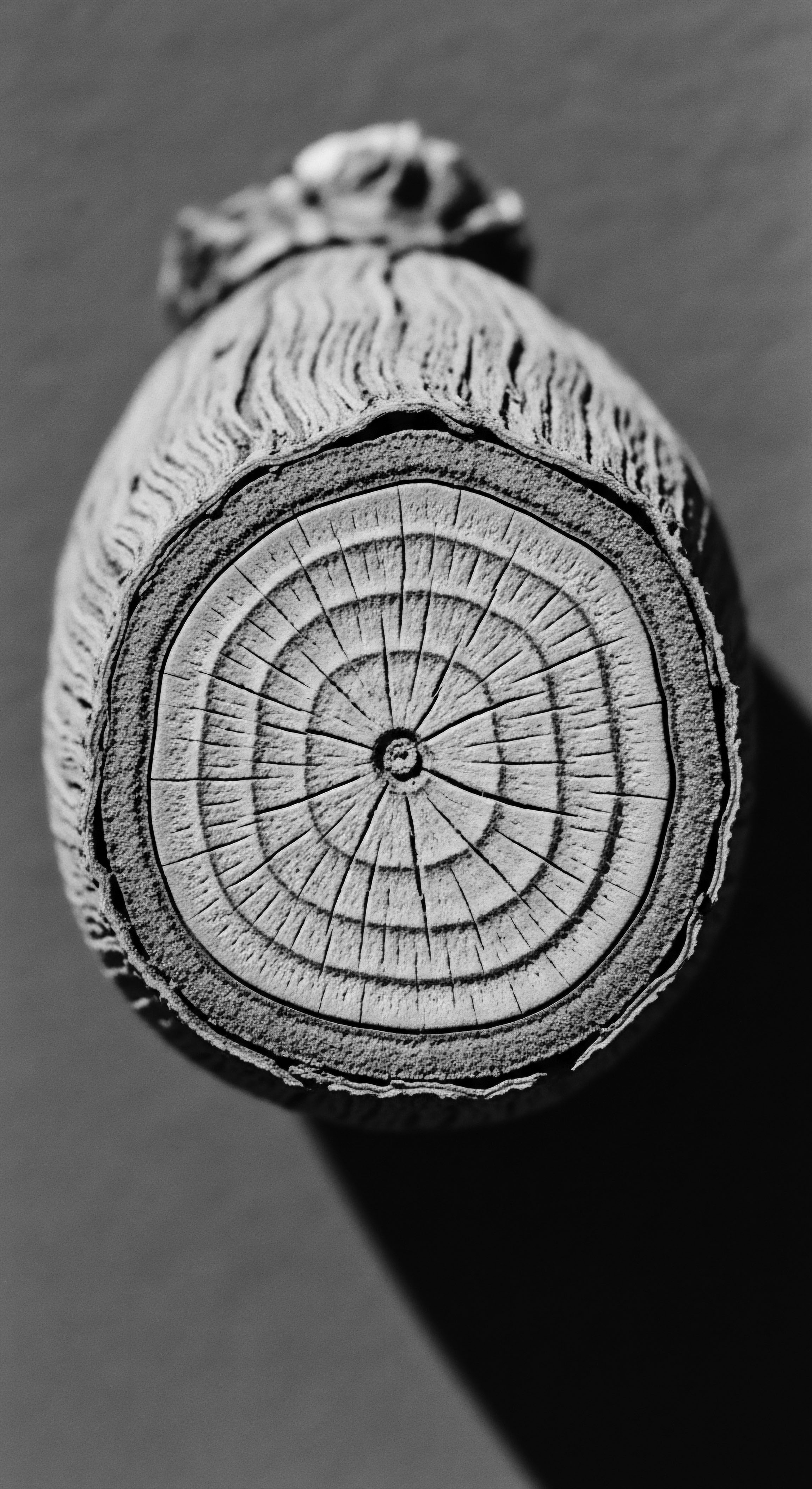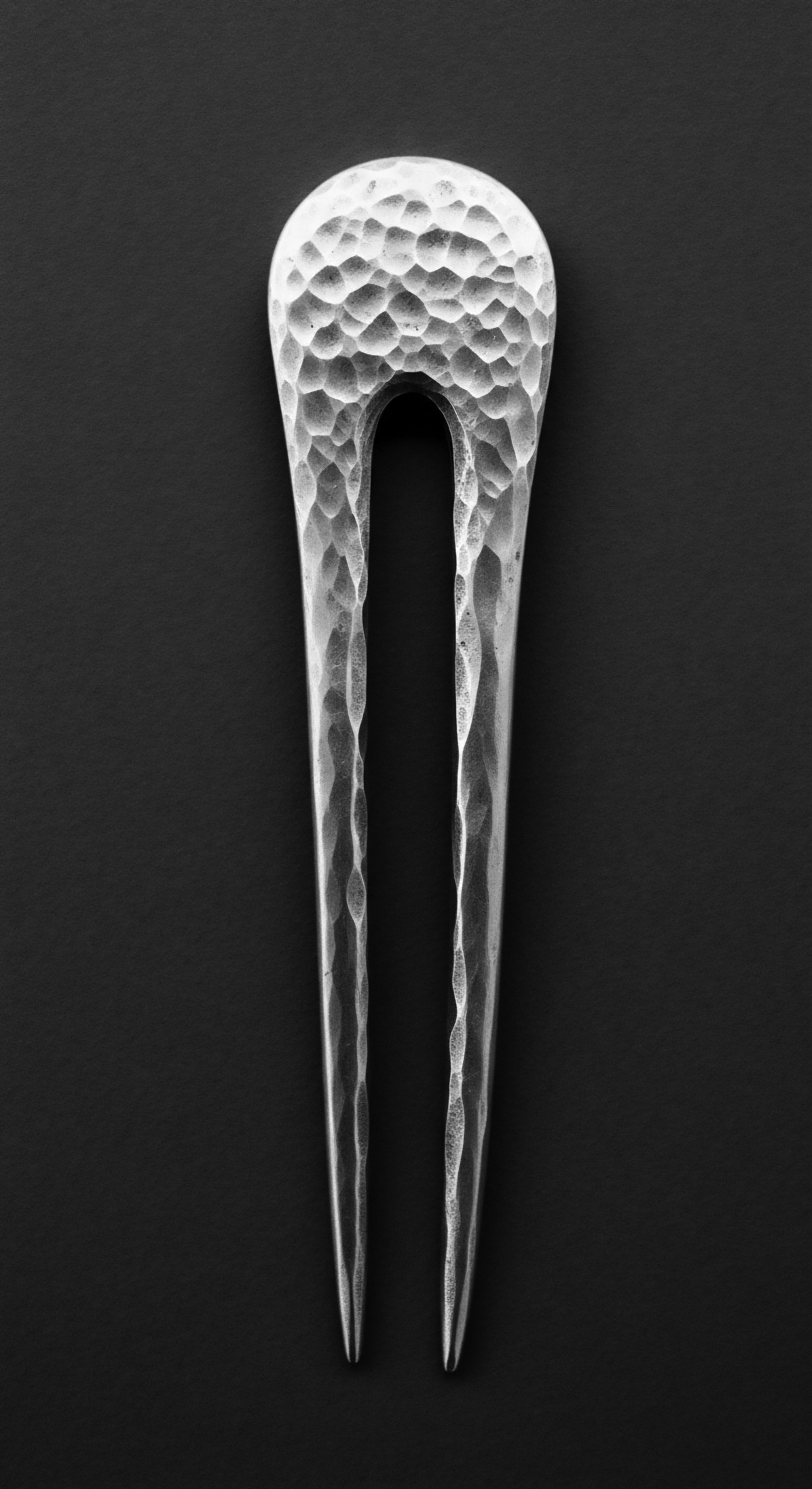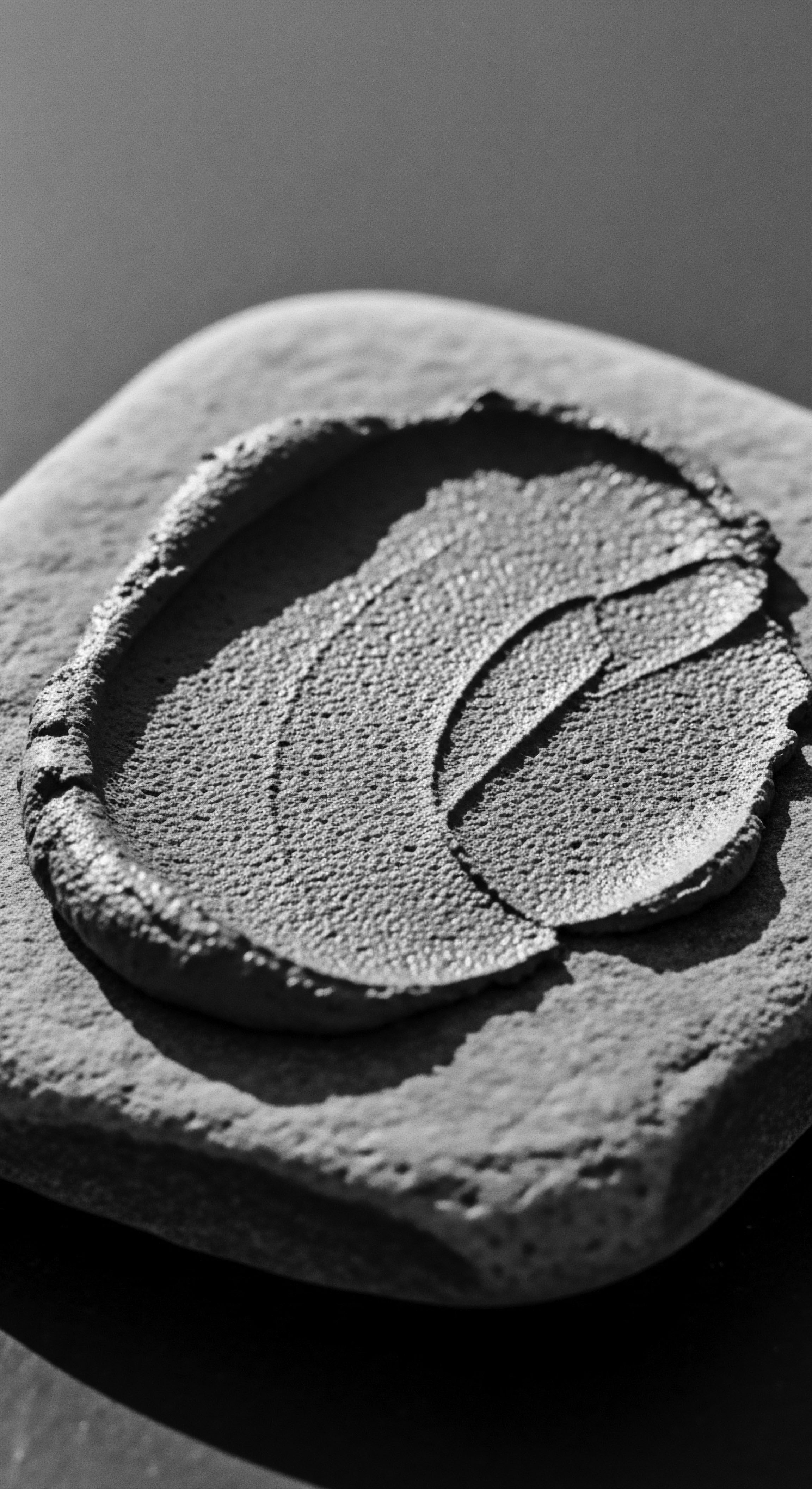
Fundamentals
The very notion of care, especially when we speak of our textured tresses, reaches back through untold generations, echoing the wisdom of those who came before. At its heart, the pursuit of vibrant, resilient hair has always involved an intricate dance with the elements, particularly water. Across varied landscapes and countless hearths, our ancestors understood, through keen observation and inherited practice, the profound influence of water quality on their hair’s vitality. This deep, experiential knowing forms the bedrock for understanding phenomena like the presence of dissolved minerals in water, an invisible force often shaping the destiny of a strand.
Within this ancient understanding, a modern scientific concept, the Chelating Agent, finds its contemporary articulation. In its simplest interpretation, a chelating agent can be understood as a molecular embrace, a gentle hand that reaches out to grasp specific metal ions, forming a stable, soluble complex. Picture it as a meticulous collector, gathering stray metallic particles that might otherwise cling stubbornly to our hair, obscuring its natural brilliance.
These are substances, naturally occurring or carefully synthesized, possessing the capacity to form multiple bonds with a single metal ion. This unique bonding characteristic allows them to effectively sequester or “trap” these ions, rendering them inactive and often allowing for their removal from a system, whether that system be the human body, a textile, or, indeed, the delicate structure of our hair.
For those new to this intricate dance of molecules and minerals, the practical Meaning of a chelating agent lies in its ability to mitigate the effects of what we often call ‘hard water.’ Water, as it journeys through the earth, gathers microscopic traces of minerals, calcium and magnesium among the most common. These metallic companions, while essential to life in other contexts, can accumulate on hair fibers, particularly on textured strands with their unique porosity and intricate coil patterns. Over time, such mineral deposits lead to a diminished luster, a perceptible dryness, and a stiffness that speaks of burdens carried by each individual strand. Understanding chelating agents begins with recognizing this subtle, yet pervasive, challenge to hair health.
Chelating agents act as molecular gatherers, gently holding onto metal ions to prevent their unwanted clinging to our hair strands.

Echoes from the Source ❉ Water and Early Hair Care
Long before the language of chemistry articulated their precise mechanisms, ancestral communities instinctively recognized the varied qualities of water from different springs, rivers, and rain collections. They observed how water from certain sources made hair feel softer, cleansed more thoroughly, and enhanced the efficacy of natural cleansers. This intuitive knowledge was a crucial aspect of their daily care rituals, shaping choices about where to wash and how to prepare hair-cleansing concoctions.
The subtle properties of chelating activity were, in essence, being employed empirically, a testament to the ingenuity and observational acuity embedded within indigenous practices. The Delineation of these agents through modern science now offers a language for what was once understood through touch, sight, and generations of passed-down wisdom.
- Rainwater ❉ Revered across many cultures for its perceived purity and softness, rainwater was often collected for washing hair and textiles. Its low mineral content meant less buildup and a more effective cleanse.
- Spring Waters ❉ Certain springs, depending on their geological paths, yielded softer water, favored for its benevolent touch on hair. Communities would often trek to these sources for specific cleansing rituals.
- Herbal Infusions ❉ Plant materials steeped in water, such as those rich in tannins or mild acids, were used to rinse hair. These infusions could subtly alter water chemistry, aiding in mineral dissolution and imparting beneficial properties.

Intermediate
Moving beyond the initial grasp of chelating agents, we approach a deeper appreciation for their intricate work within the realm of textured hair care. The story of our hair, particularly for those whose ancestral lines trace through the vibrant landscapes of Africa and its diaspora, is often one of resilience, adaptation, and an intimate connection to the earth’s offerings. Minerals, those silent travelers within our water, have always played a dual role in this narrative—sometimes a source of nourishment, sometimes a quiet impediment to the hair’s full expression. Chelating agents serve as mediators in this relationship, their chemical prowess allowing us to manage the mineral burden that our hair often carries.

The Language of Molecular Embrace
At an intermediate level, the Explanation of chelating agents delves into their specific chemical architecture. These are organic compounds, meaning they are built around carbon atoms, that possess specific functional groups capable of forming multiple bonds with a single metal ion. The term ‘chelate’ itself derives from the Greek word “chele,” meaning ‘claw,’ a wonderfully illustrative metaphor for how these molecules encircle and hold onto metal ions. The metal ion, acting as a central atom, is grasped by two or more donor atoms within the chelating molecule.
This multi-point attachment results in a stable, ring-like structure known as a chelate complex. This complex is typically soluble in water, meaning the once stubborn metal ion can now be rinsed away with ease, freeing the hair strand from its clinging burden.
The common metal ions found in hard water—Calcium (Ca²⁺) and Magnesium (Mg²⁺)—are primary targets for chelating agents. Beyond these, however, other ions like Iron (Fe³⁺) from rusty pipes or Copper (Cu²⁺) from plumbing can also accumulate, leading to discolored hair (especially lighter tones or chemically treated hair), increased brittleness, and a general lack of manageability. Chelating agents, through their ability to bind these disparate ions, become indispensable tools in restoring the hair’s natural softness and integrity. Their efficacy is not merely about cleansing; it is about restoring the hair’s innate vitality, allowing its true texture and brilliance to emerge.
Chelating agents, like molecular claws, encircle and neutralize metal ions from water, liberating textured hair from mineral buildup.

Ancestral Ingenuity ❉ Early Approaches to Mineral Mitigation
While modern science offers precise chemical names, the ancestral wisdom concerning water quality and its effects on hair is undeniable. Many traditional hair care practices, though not explicitly labeled as ‘chelating,’ demonstrably achieved similar outcomes through empirical observation and material knowledge. The use of certain natural elements reflects an early understanding of mineral mitigation.
Consider the widespread use of Clays in various African hair rituals. Rhassoul clay from Morocco, for instance, has been used for centuries for cleansing and conditioning. These natural clays possess a fascinating ability to exchange ions.
When suspended in water and applied to hair, the clay minerals can effectively draw out positively charged metal ions from the hair shaft and the water itself, adsorbing them onto their surfaces. This physical binding action parallels, in effect, the modern chelating principle of sequestering unwanted minerals.
| Ancestral Practice Clay Washes (e.g. Rhassoul, Bentonite) for cleansing and softening |
| Contemporary Scientific Link Natural ion exchange capacity; clays bind positively charged metal ions (e.g. Ca²⁺, Mg²⁺) through adsorption, similar to how some chelants work. |
| Ancestral Practice Acidic Rinses (e.g. Apple Cider Vinegar, Lemon Juice) for shine |
| Contemporary Scientific Link Lowering pH helps dissolve mineral salts (carbonates) and close cuticle, reducing new mineral adherence. Organic acids like citric and acetic acid are mild chelants. |
| Ancestral Practice Plant Decoctions (e.g. certain barks, leaves) for hair vitality |
| Contemporary Scientific Link Many plants contain natural acids, polyphenols, or other compounds with mild metal-binding or mineral-solubilizing properties. |
| Ancestral Practice Ancestral communities understood water and plant interactions on hair, often achieving outcomes consistent with modern chelating principles. |
Another example lies in the consistent application of mild acids. Rinses of Apple Cider Vinegar or diluted Lemon Juice were not simply about shine; they played a role in mitigating mineral buildup. The acetic acid in vinegar and the citric acid in lemon act as mild chelating agents themselves, capable of binding to calcium and magnesium ions and helping to dissolve existing mineral deposits. This traditional wisdom underscores a profound, lived understanding of the chemical interactions between water, hair, and the natural world, a nuanced form of care that protected the hair’s inherent moisture and coil definition.

Academic
The scholarly Delineation of chelating agents moves us into the realm of chemical precision and its profound implications for textured hair science and the legacy of its care. The very Meaning of chelation, from a rigorous academic standpoint, refers to the formation of a coordination complex between a metal ion and a ligand that contains two or more donor atoms. These donor atoms, typically oxygen, nitrogen, or sulfur, donate electron pairs to the metal ion, creating stable ring structures. The stability of these complexes, measured by their formation constants, dictates the efficacy of a chelating agent in sequestering specific metal ions from a solution.
This multi-point attachment, termed ‘multidentate,’ is the key to their superior binding affinity compared to monodentate ligands. This chemical reality has a direct bearing on the resilience and presentation of textured hair, particularly when considering the environmental exposures encountered throughout human history.
Consider the thermodynamic advantage of chelation ❉ the chelate effect, where the formation of a chelate complex is entropically favored over the formation of multiple monodentate complexes. This inherent chemical stability explains why chelating agents are so remarkably effective at removing stubborn mineral deposits from the hair fiber and maintaining water clarity in cosmetic formulations. The academic study of chelating agents also branches into their toxicology and environmental impact, demanding a careful selection of compounds that are both effective in hair care and safe for individuals and ecosystems. The pursuit of deeper Understanding of these molecular interactions allows us to re-evaluate and often validate the ingenious, empirically derived practices of our ancestors.

The Hydro-Mineral Burden ❉ A Diasporic Concern
The interaction between water quality and hair health, particularly for communities of African descent, transcends mere cosmetic concern; it touches upon socio-economic disparities and historical environmental injustices. The widespread prevalence of hard water in municipal supplies, often exacerbated by aging infrastructure, poses a disproportionate challenge to Black and mixed-race communities. These populations have historically been, and continue to be, marginalized, frequently residing in areas with substandard infrastructure, including compromised water delivery systems.
A particularly stark illustration of this burden is seen in the Flint Water Crisis, beginning in 2014. Here, a city predominantly inhabited by Black residents was subjected to lead-contaminated drinking water after a decision was made to switch the water source to the Flint River without proper corrosion control. While the immediate and devastating health impacts of lead poisoning were widely documented, the implications for hair health, particularly textured hair, were also significant, albeit less publicized. Lead, a heavy metal, can deposit onto hair shafts, altering protein structure, increasing porosity, and contributing to dryness, breakage, and scalp irritation.
Even prior to documented lead poisoning, residents reported changes in their hair and skin. A study published in the Journal of the American Academy of Dermatology noted that individuals exposed to high levels of lead in water can experience diffuse hair loss (Chai, 2018). This historical example underscores the critical role that external metallic contaminants, beyond just calcium and magnesium, play in compromising textured hair, making chelating strategies not simply a matter of aesthetics, but one of public health and restorative care for communities whose bodies and hair have been subjected to environmental assault. The Significance of chelating agents takes on a weightier context here, moving beyond simple product claims to a tool for reclamation and repair.
For textured hair, the unseen legacy of water quality, particularly in marginalized communities, means chelating agents are tools for health and reclamation.

Cultural Adaptations and the Alchemy of Ancestral Hair Care
The deep Meaning of chelating agents within textured hair heritage is perhaps best appreciated by examining the ancient ingenious solutions to water quality issues. Across the African continent and throughout the diaspora, communities developed sophisticated methods for hair and scalp care that, while not framed in modern chemical terms, implicitly addressed the very problems chelating agents solve. These were not random acts but rather carefully cultivated practices, passed down through oral traditions and embodied wisdom, often imbued with spiritual or communal significance.
- Wood Ash Lye ❉ In some West African traditions, finely sieved wood ash was mixed with water to create a mild lye solution. While highly alkaline, when used judiciously and rinsed thoroughly, this solution could react with and soften hard water. The potassium carbonate in ash acts as a water softener by precipitating calcium and magnesium ions. This was a powerful, albeit risky, early form of water treatment.
- Plant Saponins ❉ Plants like soap nuts (Sapindus mukorossi) or various roots (e.g. yucca) containing saponins were widely used as natural detergents and cleansers. While their primary action is foaming, the mild acidity and presence of other compounds within these plants could also contribute to dissolving mineral buildup or preventing its adherence. These were cherished ingredients for their effectiveness and gentle nature.
- Fermented Grain Washes ❉ In certain agricultural communities, fermented grain waters (e.g. rice water) were utilized. The fermentation process produces lactic acid and other organic acids, which, like citric acid, can contribute to chelation and acid rinsing, helping to remove mineral film and promote hair strength. This illustrates an ancient understanding of beneficial microbial processes.
These practices represent a profound ancestral Interpretation of hair care chemistry. The knowledge was experiential, often intertwined with agricultural cycles, spiritual beliefs, and community rituals. The act of washing hair with these specific materials was not just about physical cleanliness; it was an act of purification, of connection to the land, and of maintaining a vibrant aesthetic that was deeply tied to identity and social standing. The Specification of these methods, when viewed through a modern lens, reveals an extraordinary empirical science at play, demonstrating an understanding of how to manage the interaction between water and hair without recourse to laboratories or complex chemical diagrams.

Contemporary Approaches and the Preservation of Hair Heritage
Today, the Clarification of chelating agents allows for their targeted integration into modern hair care formulations designed specifically for textured hair. Ingredients such as Disodium EDTA, Tetrasodium EDTA, Citric Acid, Phytic Acid, and Sodium Phytate are commonly employed. These ingredients work by binding to metal ions in shampoos, conditioners, and treatments, preventing them from depositing on the hair.
For example, citric acid, a naturally occurring alpha hydroxy acid found in citrus fruits, is an excellent chelator of calcium and magnesium, simultaneously clarifying the hair and offering a mild exfoliating effect on the scalp. Phytic acid, derived from rice or other grains, is also a powerful natural chelator, especially effective against iron and copper.
The modern understanding of chelating agents offers an avenue for respectful Elucidation of ancestral practices. It is not about replacing traditional wisdom but about illuminating the underlying mechanisms, providing a scientific framework for why certain time-honored methods were so effective. This connection allows us to develop products that honor the heritage of textured hair care while addressing contemporary environmental challenges. For instance, formulating shampoos with specific chelating agents allows individuals living in areas with extremely hard water to experience the benefits of traditional cleansing, promoting better product penetration and reducing the risk of breakage from mineral-induced stiffness.
| Modern Chelating Agent EDTA (Disodium/Tetrasodium) |
| Role in Textured Hair Care Strong synthetic chelator; removes a wide range of hard water minerals and heavy metals. Enhances lather and product stability. |
| Connection to Ancestral Principles Emulates the deep cleansing effectiveness sought in traditional clay washes, providing a strong mineral-binding action. |
| Modern Chelating Agent Citric Acid |
| Role in Textured Hair Care Natural chelator, pH adjuster, cuticle smoother; dissolves mineral deposits. |
| Connection to Ancestral Principles Echoes the use of acidic rinses (e.g. lemon, vinegar) to soften water and enhance hair sheen and manageability. |
| Modern Chelating Agent Phytic Acid / Sodium Phytate |
| Role in Textured Hair Care Natural chelator from grains; particularly effective against iron and copper. |
| Connection to Ancestral Principles Relates to the intuitive use of grain-based preparations (e.g. rice water) for perceived hair health and strength, some of which offered mild chelating benefits. |
| Modern Chelating Agent Modern chelating agents provide targeted solutions that align with the core objectives of historical textured hair care—cleanliness, manageability, and vitality. |
The intelligent application of chelating agents in current formulations can safeguard the natural beauty of textured hair against the unseen aggressors of waterborne minerals. This approach ensures that the vibrant legacy of hair traditions can continue to flourish, unburdened by environmental stressors. The continued Explication of these compounds not only informs product development but also deepens our appreciation for the chemical intricacies that underpin the enduring strength and beauty of our hair.

The Unseen Impact ❉ Chelating Agents and Scalp Microbiome Health
Beyond the visible effects on hair strands, the academic investigation into chelating agents extends to their subtle yet significant influence on scalp health, particularly the delicate balance of the scalp microbiome. The scalp, much like the gut, hosts a complex ecosystem of microorganisms that play a pivotal role in maintaining its integrity and supporting healthy hair growth. Disruptions to this microbial harmony can lead to a host of issues, from irritation and flaking to conditions that impede healthy hair follicle function.
Heavy metal ions, whether from hard water or environmental pollution, can act as pro-oxidants, generating reactive oxygen species that damage cells and disrupt biological processes. Within the scalp’s microbial environment, these metallic intruders can influence the growth and composition of bacterial and fungal populations. Certain metal ions can inhibit the growth of beneficial microbes while potentially promoting the proliferation of undesirable ones. By sequestering these detrimental metal ions, chelating agents can contribute to a more stable and healthy scalp environment.
They reduce oxidative stress on the skin cells of the scalp and help to restore the enzymatic functions that might be impaired by metal binding. This less obvious but equally profound effect underscores the holistic Designation of chelating agents, extending their benefits beyond mere cosmetic appearance to foundational scalp wellness, a principle implicitly understood by ancestral healers who prioritized a healthy scalp as the root of strong hair.

Reflection on the Heritage of Chelating Agents
As we gaze upon the intricate pathways traced by chelating agents, from their elemental biology to their sophisticated presence in modern care, we find ourselves on a profound journey through time and tradition. The science of chelation, with its precise molecular grasp, becomes a respectful dialogue with the empirical wisdom of our ancestors, a conversation across centuries that celebrates the enduring spirit of textured hair. For generations, communities have understood that hair is not merely adornment; it is a repository of identity, a visual lexicon of lineage, and a canvas for expression.
The story of chelating agents, when filtered through the lens of Black and mixed-race hair experiences, is a testament to resilience. It speaks to the ingenuity of those who, through observation and inherited knowledge, navigated environmental challenges with solutions born of the earth itself. The meticulous selection of specific clays, the purposeful use of acidic rinses, the nuanced preparations of plant materials—these were not just acts of cleaning.
They were acts of preservation, of connection to ancestral practices, of a continuous commitment to nurturing the very strands that carried stories, histories, and triumphs. The ability of certain compounds to cleanse and purify, to strip away the unseen burdens of water, allowed our hair to retain its unique strength and inherent beauty, ensuring that the visual language of coils and kinks could continue to speak volumes.
In every drop of water, every mineral particle that touches our hair, there lies an invitation to remember. Remember the meticulous care passed down through grandmothers’ hands, the communal rituals by the riverbanks, the ancestral determination to maintain hair’s integrity against all odds. Chelating agents, in their contemporary form, become guardians of this legacy, helping to protect hair in ways that honor the deep intelligence of the past.
Their continued Import extends beyond the laboratory, touching the very soul of a strand, helping it to remain unbound, vibrant, and a living testament to an unbroken heritage. Our hair, truly, is a profound archive of care, and understanding the role of chelating agents helps us read its intricate chapters with renewed appreciation and reverence.

References
- Chai, X. H. (2018). Hair analysis in determining exposure to lead in children. Journal of the American Academy of Dermatology, 78 (5), e107.
- Ghasemi, B. & Tabrizi, M. A. (2018). Chelating agents in hair care formulations ❉ A review. Journal of Cosmetic Science, 69 (4), 213-228.
- Obasi, N. A. (2007). African Hairstyles ❉ A cultural and historical exploration. Fountain Publishers.
- Poucher, W. A. (2012). Poucher’s Perfumes, Cosmetics and Soaps (10th ed.). Springer Science & Business Media.
- Robbins, C. R. (2012). Chemical and Physical Behavior of Human Hair (5th ed.). Springer Science & Business Media.
- Stewart, R. (2013). The Science of Hair Care. CRC Press.
- Walton, P. T. (2009). Bioinorganic Chemistry ❉ A Short Course (2nd ed.). Oxford University Press.
